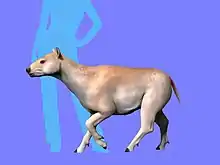| Proterotheriidae Temporal range: | |
|---|---|
_(14749873255).jpg.webp) | |
| Skeleton of Thoatherium | |
| Scientific classification | |
| Domain: | Eukaryota |
| Kingdom: | Animalia |
| Phylum: | Chordata |
| Class: | Mammalia |
| Order: | †Litopterna |
| Suborder: | †Lopholipterna |
| Superfamily: | †Proterotherioidea |
| Family: | †Proterotheriidae Ameghino 1887 |
| Synonyms | |
| |
Proterotheriidae is an extinct family of litoptern ungulates known from the Oligocene-Late Pleistocene of South America. Members of the group were small-medium sized cursorial herbivores with brachydont teeth, with their toes showing progressive reduction, with later members of the group bearing weight on a single large toe similar to living horses.[1]
Description
_(14563211299).jpg.webp)
Two subfamilies and 18 genera of Proterotheriidae are known. All forms were small or medium-sized. Typical is a reduction of the number of toes and brachydont or mesodont teeth. The family is recorded since the late Palaeocene. Various fossils are known from many parts of the South American continent. The diversity decreased in the Miocene to Pliocene and it has been assumed for a long time that they entirely disappeared in the late Pliocene. However, fossils found in Argentina, Brazil and Uruguay show that one member of the group, Neolicaphrium recens survived into the Late Pleistocene.[2][3][4]
Better known genera of the family include Diadiaphorus and Thoatherium from the Miocene.[2]

Taxonomy
- Proterotheriidae[5][6]
- Anisolambda
- Anisolophus
- Brachytherium
- Diadiaphorus
- Diplasiotherium
- Eoauchenia
- Eolicaphrium
- Epecuenia
- Epitherium
- Guilielmofloweria
- Heteroglyphis
- Lambdaconus
- Lambdaconops
- Mesolicaphrium
- Neobrachytherium
- Neodolodus
- Neolicaphrium
- Olisanophus
- Paramacrauchenia
- Paranisolambda
- Picturotherium
- Prolicaphrium
- Promylophis[7]
- Proterotherium
- Protheosodon
- Pseudobrachytherium[8]
- Tetramerorhinus
- Thoatherium
- Thoatheriopsis
- Villarroelia
- Uruguayodon
- Wainka
- Xesmodon
- Megadolodinae
- Indaleciidae
- Adiantoides
- Indalecia
Proterotheriidae is traditionally considered to include two subfamilies, Anisolambdinae and Proterotheriinae. Anisolambdinae (also called Anisolambdidae in some studies) was proposed to unite the primitive and earlier forms Anisolambda, Eolicaphrium, Paranisolambda, Protheosodon, Guilielmofloweria, Heteroglyphis, Lambdaconops, Wainka and Xesmodon. However, the phylogenetic analysis of McGrath and colleagues recovered the included genera to neither form their own clade, or to universally represent basal taxa outside the genera of Proterotheriinae per Soria, making Anisolambdinae a polyphyletic group of unrelated organisms.[6]
Proterotheriidae was redefined by McGrath and colleagues in 2019 to be all taxa closer to Tetramerorhinus than Macrauchenia, Tricoelodus or Protolipterna.[5] The cladogram below shows the modified results of their phylogenetic analysis, where incomplete taxa were placed based on morphology. The unrelated genera of the polyphyletic taxon Anisolambdinae or Anisolambdidae is highlighted in pink.[6]
| Proterotheriidae |
| |||||||||||||||||||||||||||||||||||||||||||||||||||||||||||||||||||||||||||||||||||||||||||||||||||||||||||||||||||||||||||||||||||||||||||||||||||||||||||||||||||||||||||||||||||||||||||||||||||||||||||||||||||||||||||||||||
References
- ↑ Carrillo, Juan D.; Suarez, Catalina; Benites-Palomino, Aldo Marcelo; Vanegas, Andrés; Link, Andrés; Rincón, Aldo F.; Luque, Javier; Cooke, Siobhán B.; Tallman, Melissa; Billet, Guillaume (2023-08-31). "New remains of Neotropical bunodont litopterns and the systematics of Megadolodinae (Mammalia: Litopterna)". Geodiversitas. 45 (15). doi:10.5252/geodiversitas2023v45a15. ISSN 1280-9659. S2CID 261638835.
- 1 2 Scherer, C.; Pitana, V.; Ribeiro, A. M. (2009). "Proterotheriidae and Macraucheniidae (Litopterna, Mammalia) from the Pleistocene of Rio Grande do Sul State, Brazil". Revista Brasileira de Paleontologia. 12 (3): 231–246. doi:10.4072/rbp.2009.3.06.
- ↑ Ubilla, M.; Perea, D.; Bond, M.; Rinderknecht, A. (2011). "The first cranial remains of the Pleistocene proterotheriid Neolicaphrium Frenguelli, 1921 (Mammalia, Litopterna): a comparative approach". Journal of Vertebrate Paleontology. 31 (1): 193–201. doi:10.1080/02724634.2011.539647. S2CID 84000052.
- ↑ Gaudioso, P. J.; Gasparini, G. M.; Herbst, R.; Barquez, R. M. (2017). "First record of the Neolicaphrium recens Frenguelli, 1921 (Mammalia, Litopterna) in the Pleistocene of Santiago del Estero Province, Argentina". Papéis Avulsos de Zoologia. 57 (31): 23–29. doi:10.11606/0031-1049.2017.57.03.
- 1 2 McGrath, A.J.; Flynn, J.J.; Wyss, A.R. (2019). "Proterotheriids and macraucheniids (Litopterna: Mammalia) from the Pampa Castillo Fauna, Chile (early Miocene, Santacrucian SALMA) and a new phylogeny of Proterotheriidae". Journal of Systematic Palaeontology. 18 (9): 1–22. doi:10.1080/14772019.2019.1662500. S2CID 204142828.
- 1 2 3 Andrew J. McGrath; Federico Anaya; Darin A. Croft (2020). "New proterotheriids (Litopterna, Mammalia) from the middle Miocene of Quebrada Honda, Bolivia, and trends in diversity and body size of proterotheriid and macraucheniid litopterns". Ameghiniana. 57 (2): 159–188. doi:10.5710/AMGH.03.03.2020.3268. S2CID 216236954.
- ↑ Shockey, Bruce J.; White, Emily; Anaya, Federico; McGrath, Andrew (2023-01-26). "A new proterotheriid (Mammalia, Litopterna) from the Salla Beds of Bolivia (upper Oligocene): phylogeny and litoptern patellar pit knee locks". Journal of Vertebrate Paleontology. 42 (2): e2162409. doi:10.1080/02724634.2022.2162409. ISSN 0272-4634. S2CID 256355550.
- ↑ Corona, A.; Badín, A.C.; Perea, D.; Ubilla, M.; Schmidt, G.I. (2020). "A new genus and species and additional reports of the South American native ungulates Proterotheriidae (Mammalia, Litopterna) in the Late Miocene of Uruguay". Journal of South American Earth Sciences. 102: 102646. doi:10.1016/j.jsames.2020.102646. S2CID 219425197.




.jpg.webp)



